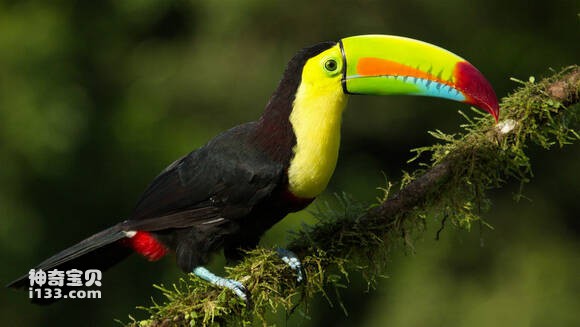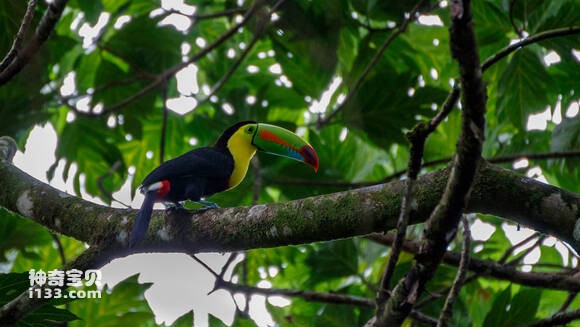Ramphastos sulfuratus
IUCN
LCBasic Information
Scientific classification
- name:Ramphastos sulfuratus
- Scientific Name:Ramphastos sulfuratus,Keel-billed Toucan
- Outline:Climbing birds
- Family:
Vital signs
- length:About 52 cm
- Weight:About400g
- lifetime:No textual research information is available
Feature
Distribution and Habitat
The thick-billed toucan is found in Belize, Colombia, Costa Rica, Guatemala, Honduras, Mexico, Nicaragua, Panama, Venezuela.
The thick-billed toucan lives mainly in lowland rain forests, sometimes in nearby open areas with sparse trees. They are rarely seen above 1,700 metres above sea level.
Appearance
The thick-billed toucan is a medium-sized climbing bird with a body length of 52 centimeters and a weight of about 400 grams. The body feathers are mainly navy blue black, the breast is a bright lemon yellow, the white rump, the blue feet, the ventral side of the tail is bright red, and a large colored beak has multicolor patches.
The nostrils of the adult bird are hidden under the base of the beak. A bird's beak is actually very light, not nearly as heavy as it looks. The outside is a thin sheath of keratin, the inside is hollow, but there are many thin bone support rods staggered. The tongue of the thick-billed toucan is very long, the beak margin is clearly serrated, the base of the beak is surrounded by a black line spot, no mouth whiskers. The skin on the exposed part of the face and jaw is usually brightly colored. The eyes are black with sky blue circles around them.
Details
The thick-billed Toucan, whose scientific name is Ramphastos sachatus, Keel-billed Toucan, has two subspecies (1. Barrel-ribbed thick-billed toucan: Ramphastos sachyatus brevicarinatus. 2. Rainbow Toucan: Ramphastos Sachyatus sachyatus.)

Thick-billed toucans usually live in small groups of 6 to 12 individuals. Sleep with your huge mouth on your back and your tail held high so you take up less space. These toucans feed in loose formations from tree to tree. The bird's song is hoarse and low, similar to that of a tree frog. It is omnivorous, feeding on fruits, seeds and insects, and sometimes raiding the nests of small birds, eating eggs and chicks. Increase your protein intake by eating these non-plant foods. After the toucan swallows the fruit, it can spit out the seeds, spreading the parent plant over great distances and facilitating the planting of the plant.

Thick-billed toucans are monogamous and very territorial. Choose natural wood good tree holes for the nest, also choose the woodpecker carved old tree holes. The opening is just wide enough for the adult bird to penetrate, and the hole is between 17 cm and 2 m deep. The presence of suitable burrows near the root of the tree will also attract birds that normally nest in high places to nest near the ground. - Laying 2 to 4 eggs at a time, the smooth white eggs are piled in unlined holes, and the incubation period is 16 to 20 days; The hatchlings are completely naked and need at least 3 weeks to open their eyes. Both parents feed them together and stay in the nest for 8 to 9 weeks. After that, the young birds begin to live their own lives independently in the leaf cluster.
Listed on the International Union for Conservation of Nature (IUCN) 2012 Red List of Threatened Species ver 3.1 - Low Risk (LC).
Listed in Appendices I, II and III of the Convention on International Trade in Endangered Species of Wild Fauna and Flora (CITES) 2019 edition Appendix II.
Protect wild animals and eliminate wild meat.
Maintaining ecological balance is everyone's responsibility!








